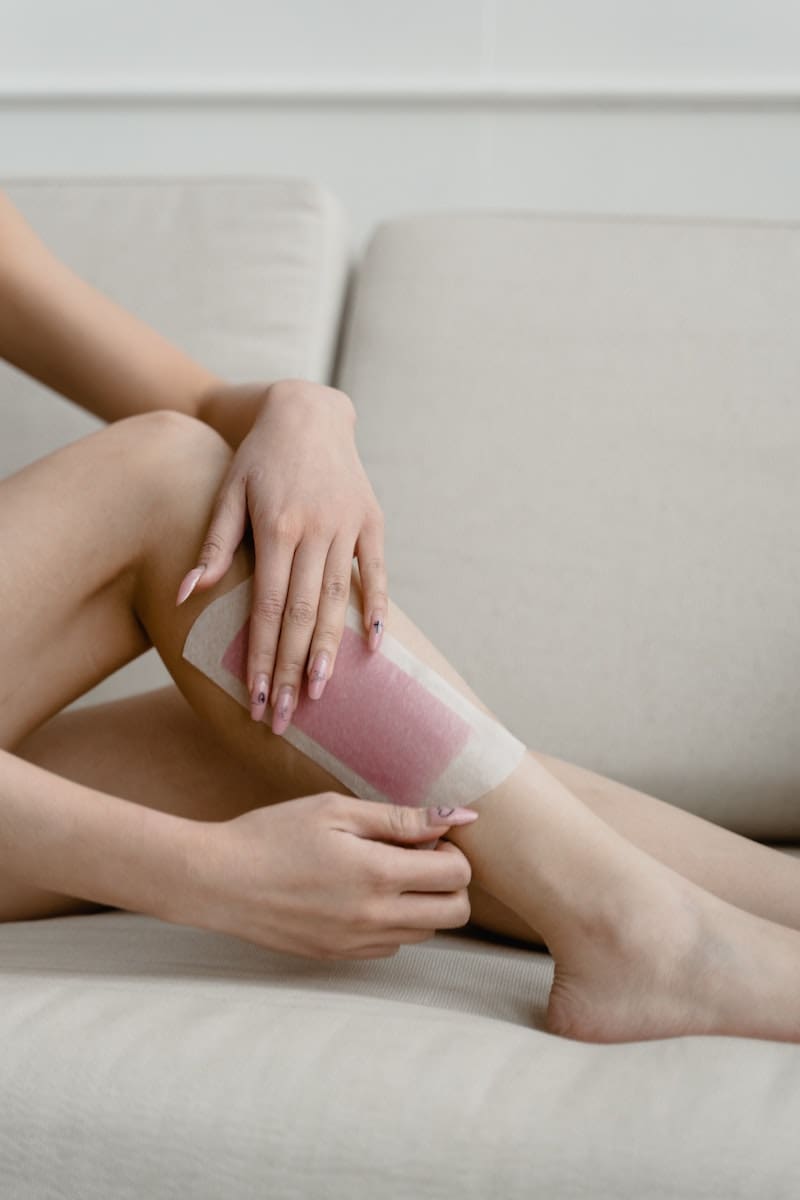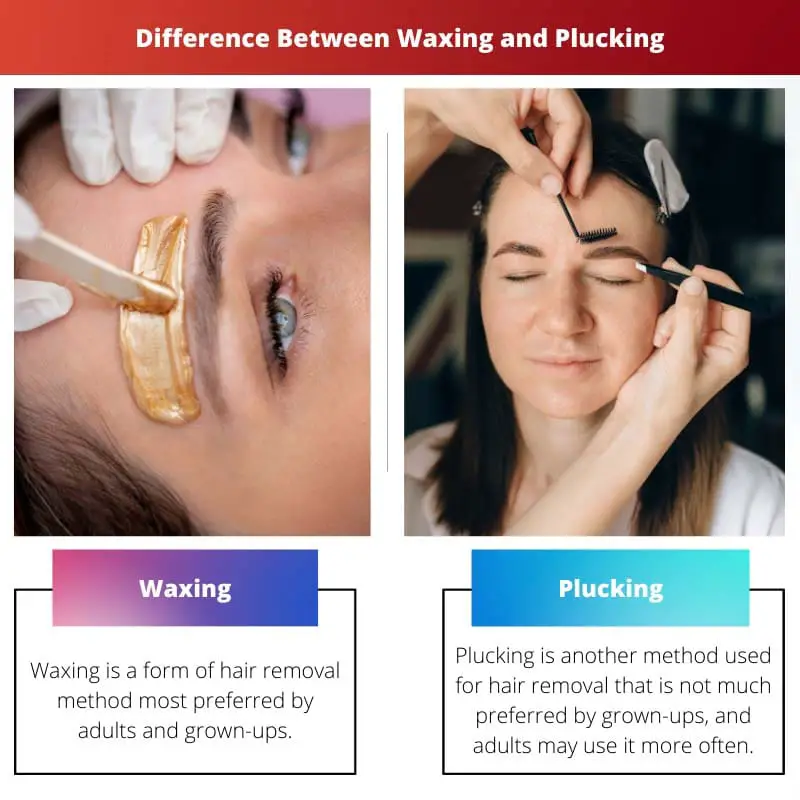Hair removal methods have been quite popular among grown-ups and adults. Some of these methods have been practiced since ancient times.
Many of the procedures involve painful processes like – waxing, plucking, sugaring, and others, while some of them are painless procedures that are found gradually with the need of the hour.
Key Takeaways
- Waxing removes hair by applying wax and quickly stripping it away, while plucking involves manually pulling out hairs with tweezers or similar tools.
- Waxing provides longer-lasting results and removes large areas of hair at once, whereas plucking targets individual hairs and requires more time.
- Plucking causes less skin irritation and is better suited for precise hair removal, while waxing may be more painful and prone to ingrown hairs.
Waxing vs Plucking
The difference between Waxing and Plucking is that waxing is stated to be a method in which the hot wax or cold wax is applied to the area that is to be treated, and then the hair from the area is pulled out by using the muslin cloth or strips. In contrast to that, the plucking method is stated as the pulling out of hairs directly from the roots themselves.

Waxing is a method widely acceptable and comfortable way for removing unwanted hairs from different body parts. The method is used to treat areas like – hands, legs, face, bikini line, etc.
The ingredients used to make the wax includes – natural extracts like cocoa, aloe vera, strawberry, etc., and some chemicals in it.
Plucking is a method more used to pull out small hairs that gets unnoticed during different hair removal treatments.
Preferably, the method is used to pull out hairs from the eyebrows and facial hairs. It is done with the help of metal pointed end equipment called tweezers.
Comparison Table
| Parameters of Comparison | Waxing | Plucking |
|---|---|---|
| Material Required | Wax (Hot or Cold), Muslin Cloth/Strips | Tweezers |
| Hair Length | Around 1/4th | Can be of any length |
| Temperature | Hot wax needed to be melted down at a certain temperature while cold wax can be used as it is. | Not applicable |
| Side Effects | Irritation, redness, bumps, inflammation | Redness |
| Direction | Same as hair growth direction | No such criteria |
| Products After Use | Any essential oil, moisturizer, or lotions can be applied. | Baby powder or any lotion |
| Effectiveness | Up to 4 to 6 weeks | Depends upon the body hair growth |
What is Waxing?
Waxing is a form of hair removal method most preferred by adults and grown-ups. In ancient times also the method was commonly used, but the origination of the method is said to be in 1150 BC Egypt.
At that time, the solution applied to the area to be treated was mainly made up of all the natural ingredients, but nowadays, the ingredients of the solution or the wax are based on more chemicals and less natural ingredients as they have few extracts only.
The procedure of application of waxing includes some steps, and they are –
- Heat the wax contents to a certain temperature
- Mix the contents properly
- Apply the wax (hot or cold) to the affected area
- Leave for a few seconds
- Pull out the wax through the help of muslin cloth/strips
After the completion of the process, it is advised to apply any essential oil, moisturizer, or lotions for soothing the skin and to prevent any side effects like – redness, inflammation, redness, or bumps.

What is Plucking?
Plucking is another method used for hair removal that is not much preferred by grown-ups, and adults may use it more often. It is a method that involves plucking hair directly from the roots with the help of pair of tweezers.
Although the method is restricted to certain areas like eyebrows and upper lips. This is so because, in the procedure, a single hair is plucked out, causing the roots of the hair to be thicker.
This results in thicker hairs. Also, the affected area skin gets more stimulated, resulting in increased blood supply, which strengthens the follicles.
The major treated areas for tweezers that have been used are – shaping eyebrows, upper lips, removing ingrown hairs, single hair strands, etc.
The side effects of the method may cause redness in the area. So to avoid this, it is advised to use or apply lotion or baby powder at the treated surface.

Main Differences Between Waxing and Plucking
- In the process of waxing, the material requirements are the choice of wax to be applied (hot or cold) and muslin cloth or strips, while comparatively, on the other hand, the material required for the process of plucking is the pair of tweezers.
- The minimum hair length requirement for the smooth process of waxing is approximately 1/4th while comparatively, on the other hand, in the process of plucking, there is not as such desired hair length for it.
- The minimum temperature requirement during waxing is the one just to melt down the hot wax (as cold wax doesn’t need to be melted before application) while comparatively, on the other hand, there is no such criteria or need of temperature in the plucking method.
- The general side effects experienced after waxing are – redness, inflammation, bumps, irritation, while comparatively, on the other hand, the general side effects experienced after using the plucking method include redness in the treated area.
- The hair direction during application of the wax should be the same as of the hair growth while comparatively, on the other hand, in the plucking hair removal method, there is no requirement for hair direction.
- The products used after waxing include – essential oils, moisturizer, or lotion, while comparatively, on the other hand, the products used after the plucking method are – baby powder or lotion.
- The effectiveness of the waxing procedure is for 4 to 6 weeks, while comparatively, on the other hand, the effectiveness of the plucking method depends on the hair growth of different individuals.

- https://www.cambridge.org/core/journals/environmental-conservation/article/abs/modern-technology-and-customary-use-of-wildlife-the-harvest-of-sooty-shearwaters-by-rakiura-maori-as-a-case-study/20C4FED5C5478EB04DD8AB83D53E9ABF
- https://onlinelibrary.wiley.com/doi/full/10.1111/ics.12648
- https://academic.oup.com/jcem/article/85/1/89/2852067?login=true




